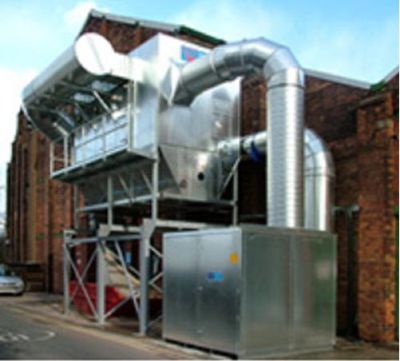Question
I have been told that if I have the extraction fan on the pull side of the filter housing, instead of the push side, it will mean the filter housing will have to be made from thicker steel and the filter bags will have to be made thicker, as they will need to be stronger. Is this true, and why?
Below is the sort of filter housing I'm talking about. I'm guessing it is called a filter housing but I don't know for sure. In the picture it's the big metal container on stilts above the skip.
In fact, the system in the picture may have the fan on the pull side. I say this because the ducting from the fan enters the filter housing at the top instead of the bottom. Can anyone make out if the fan is on the pull or the push side of the filter housing?

Forum Responses
(Dust Collection and Safety Equipment Forum)
From contributor J:
In the US we call that a bag house. Fan on the clean air side is better - cleaner but more costly. I ended up with a fan on dirty side unit a few years ago when we upgraded. It is fine but I think the other type is cleaner. Before that we had a Murphy Rodgers bag house with a clean air fan. The filters on the new unit are thicker.
Other advantages for clean air fan include quieter operation and reintroduction of clean air back into facility, eliminating need for makeup air to avoid negative building space (although this has become a hot spot with OSHA/NFPA regulations as relates to fire hazards - check with local authorities having jurisdiction).
